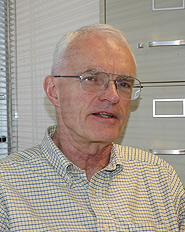Berkeleyan
 |
The magnitude 6.9 Northridge earthquake of 1994 caused structural damage to every building on the Cal State Northridge campus (left). Electricity, water, gas, and most phone communications were interrupted; fires burned for hours; the main campus library was unusable for more than a year. (Photo courtesy Cal State Northridge) |
Getting Berkeley ready for business as unusual
After disaster strikes the region, critical campus functions will need to be resumed. Some 'incredible efforts' to plan for that day have already been made
![]()
| 18 January 2006
Recent events in New Orleans, where a potential collapse of the levee system has been feared for decades, are a fresh reminder that worst-case scenarios sometimes do become realities. Sitting astride the Hayward fault, that lesson is not lost at UC Berkeley, which has spent the better part of a decade preparing for the worst - by strengthening buildings through the campus SAFER Program; developing disaster-related policy via the Disaster-Resistant University Program; and preparing, through the UC Police Department's Office of Emergency Preparedness, for emergency response immediately following a disaster.
 Paul Dimond (Cathy Cockrell photo) |
A longer interruption, the thinking goes, would likely prompt the campus to cancel the semester - as Tulane, Dillard, Southern, and other universities and colleges in New Orleans did last fall. Those institutions have also had to disperse students to schools around the country, lay off faculty and staff, and radically redesign their academic programs. ("We will get stronger by subtraction," Tulane's president, Scott Cowen, said in early December, announcing a sweeping restructuring that entails the end of a number of academic and athletic programs and layoffs for more than 200 faculty members, some of them tenured.)
If Berkeley were forced, similarly, to stay closed for an extended period, the concern is that faculty and students might quickly begin to consider other options. "Our eminence creates vulnerability, because many of our faculty could easily go elsewhere if they were unable to resume teaching and research in a reasonable time," says Paul Dimond, manager of Berkeley's Office of Business Resumption (OBR).
Departmental plans
The campus's 2001 business-resumption plan called for individual campus units to prepare similar documents. OBR was launched, in response, to assist departments with their planning, and to develop tools to make the task less daunting. As OBR literature notes, "No amount of campus-level preparation will get us 'back in business' following a major disaster, unless individual schools and departments prepare as well."
| IST has recovery on its mind How prepared is IST to resume such online operations as processing paychecks and handling class registration in the event of a disaster? |
A 25-year campus veteran assigned to work fulltime on this project, Dimond meets with administrators in schools and departments across campus to assist them in planning for disaster. He has developed and tweaked a bare-bones, easy-to-use template - currently on paper but soon to be a web-based tool called Restarting Berkeley. OBR's Business Resumption Planning Guide (downloadable at obr.berkeley.edu) helps administrators identify which of their unit's functions are critical; think about how they would jump-start those functions following a disaster, absent a full complement of staff, computers, space, or other resources; and decide what steps can be taken now to limit damage and make a swift rebound more likely.
Preventative steps can be as simple as attaching shelving or equipment securely to a wall or stable surface or arranging to launch web pages, in an emergency, from a location outside the Bay Area. Proper back-up of computers is another sure bet.
Users of the planning template are asked to identify, for example, which of their records are critical, where they're located, and how they're backed up and secured; the names and contact information for staff, clients, campus partners, and outside vendors; and the minimum resources, in terms of equipment and facilities, needed to resume critical functions.
"When you first think of business resumption, it seems big, overwhelming, daunting," says Nina Hundley, Information Systems and Technology's business-resumption coordinator (see sidebar, below, on IST business-resumption planning). The OBR planning tool "gets someone to start focusing," she says. "Once you do that, you can start thinking and looking at the steps, instead of looking at this big, huge, ugly monster."
To date, some 30 campus units - from small offices to colleges and departments - have begun or completed business-resumption plans with help from OBR. The College of Natural Resources, encompassing four departments, recently completed its game plan. "People in our college work with fire, water, in the field - it makes us aware of what nature can throw at us," say Paul Ludden, dean of the college. "Maybe for that reason we're intent on being prepared for what can happen."
Haas School of Business is in the process of creating a plan, as are the Office of the Vice Chancellor for Research and Residential & Student Service Programs; the latter's responsibility for housing and food would be critical in a disaster.
The School of Public Health, whose faculty conducts both behavioral and lab-based research and has responsibilities for public-health-related disaster response, has begun to work closely with OBR; Environment, Health and Safety (EH&S); and the Disaster-Resistant University Program as part of its own effort to become a model disaster-resistant academic unit.
Research resumption is a critical concern. Professor of Public Health Robert Spear, chair of the Academic Senate's Disaster Preparedness Working Group, says the current "front-burner" issue there is how faculty can be aided in preparing to resume their research following a disaster.
With an ounce of prevention, faculty can do much to safeguard their data, materials, and lab animals. Sarah Nathe, manager of the campus's Disaster-Resistant University Project, says the campus "at every level" is trying to promote loss reduction. Her office, OBR, the Senate working group, EH&S and its Q-Brace program, "all stand ready to help with technical assistance." It's very cost-effective to take the steps ahead of time to protect valuable equipment, she notes. "The Q-Brace Program helps, typically on a department level. But individual PIs or their lab managers must take a little time and do the prep work." (EH&S plans to relaunch the Q-Brace program, which provides matching funds for units wishing to secure building contents, around Feb. 1; revised details will be available at that time, at ehs.berkeley.edu/qbrace.html).
A sea change
Departmental business-resumption plans in various stages of completion line the bookshelves of Dimond's University Hall office. Some are thick - though bulk is not the point, he notes. In contrast to other planning processes where detail is a virtue, "We don't know the conditions we'll be faced with. So you try to keep your plan conceptual enough that you don't get bogged down."
"You can't make the planning so precise that it's out of date in 20 minutes," says Professor of Architecture Mary Comerio, a specialist in nonstructural hazard reduction and an international expert in post-disaster reconstruction issues. "Sometimes you can't decide everything ahead of time, but you can decide who's going to decide. If you create the process ahead of time, you won't waste time [in a disaster] fighting about that."
Hurricanes Katrina and Rita, like the Northridge and Loma Prieta earthquakes in California, have provided many cautionary tales for Berkeley planners. Loma Prieta did significant damage on the Stanford campus; Northridge closed down Cal State Northridge for a month. Both universities had to find ways to resume classes and research in the midst of reconstruction. At campuses in New Orleans following Katrina, communications, security, power, fuel for back-up generators, potable water, gas and sanitary sewers, computer systems, and data were affected. Research materials were damaged, students and faculty displaced, cash flow impaired.
For Comerio, one of the sobering lessons of Katrina emanates from Tulane, a four-year research university and Berkeley's closest counterpart in New Orleans. "They've had to be a village unto themselves - providing food, grocery stores, schools, daycare, hospitals," she says. "They have had not to depend on the surrounding city for much of anything in order to get their faculty back, their students back."
If a powerful quake on the Hayward fault disrupted local transportation, water, power, and/or natural-gas lines, she says, "we would be facing many of the same issues. You might really have to pull into yourself to keep the university open."
Comerio is encouraged, however, by the scope and seriousness of the campus's disaster planning for those circumstances it can do something about. "There's been a series of incredible efforts on the business side," she says, as well as thoughtful analysis and planning around teaching and research recovery. "A decade ago, I couldn't get anyone to take me seriously. Now it's becoming a much more common conversation - how to protect data, equipment, and experiments.. There's been a sea change."
The Office of Business Resumption hopes to keep that conversation alive across the campus, where the best of intentions to do advanced planning can be easily derailed by the demands of the moment.
"We have something really special here at Berkeley, built up over many, many years, and I would so hate to see that seriously changed in the 20 seconds of a big earthquake," Dimond says. "What would personally pain me most is if we were to suffer harm that preparation could have avoided."

